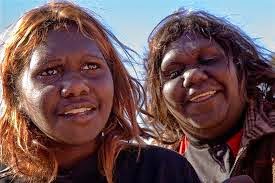I
Today, the “hybrid genotype and phenotype” are well preserved amongst the aboriginals in main land Australia, but to a lesser degree in West Papua and Solomon Island. The pure Denisovans’ genotype and phenotype are well preserved amongst the Papua New Guineans; whereas, the pure Homo sapiens’ genotype and phenotype are well preserved amongst the Solomon and Vanuatu Islanders, but to a lesser degree amongst the Papua New Guineans. In fact, in one of the Solomon Islanders' folklores that I read, it says that the Solomon Islanders’ progenitors migrated from Tanzania (East Africa) 40,000-60,000 years ago, and many of their elders today testify to the truth of this East-African migration theory.
To further buttress my hypothesis, let me refer you to an article published by Carl Zimmer in the Discover magazine this year (“Intebreeding with Neandethals,” March 04, 2013). In it, Carl says: “the Denisovan genes were closest to the Neanderthals, but the genome had many mutations not found in either humans or Neanderthals. Denisovan ancestors apparently had diverged from the ancestors of Neanderthals somewhat more recently than the split between Neanderthals and modern human beings. It is possible that their common ancestor emigrated from Africa many hundreds of thousands of years ago. The ancestors of Neanderthals headed north....The Denisovans’ ancestors, meanwhile, headed east and survived long enough to at least leave that pinkie bone in the Siberian cave......Knowing that Neanderthals and humans had interbred, Reich and his colleagues (The Harvard researches) looked carefully for Denisovan DNA in the genomes of living humans. They found it in genomes from two populations, one from New Guinea and another from the nearby island of Bougainville. As much as 5 percent of their DNA came from the vanished Denisovans.” (http://discovermagazine.com/2013/march/14-interbreeding-neanderthals).
 |
| The mixed type - African/Denisovan type |
 |
| The unmixed - 100% African type |
 |
| The unmixed - 100% Denisovan type |
Most of the mainstream archeologists and evolutionary anthropologists believe that the Australian aboriginals descended from a group of Homo sapiens, who were said to have left Africa about 40,000-70,000 years ago for Australia. However, in my proposed hybridization theory, I am suggesting that the Australian aboriginals are largely a product of interbreeding between the Homo sapiens and the Homo Denisovans (subspecies of Homo sapiens, native to the Australian sub-continent).
What am I really trying to convey? I am proposing that the proto-inhabitants of the Australian sub-continent were Homo Denisovans who were well adapted to that environment. However, about 40,000-70,000 years ago, a group of Homo sapiens left Africa and journeyed into Australian sub-continent where they encountered Homo Denisovans and interbred with them to survive in an unfamiliar environment. Of course, in most cases of interbreeding, not everyone in the population is (un)fortunate enough to be absorbed into the admixture – some remain unmixed. Similarly, in the case of the Australian aboriginals, some of them are a product of the admixture between the African immigrants (i.e. Homo sapiens) and the natives (i.e. Homo Denisovans), but a number of them are not mixed at all – that is, a number of them are descendants of either the pure-bred Homo sapiens or Denisovans.
Today, the “hybrid genotype and phenotype” are well preserved amongst the aboriginals in main land Australia, but to a lesser degree in West Papua and Solomon Island. The pure Denisovans’ genotype and phenotype are well preserved amongst the Papua New Guineans; whereas, the pure Homo sapiens’ genotype and phenotype are well preserved amongst the Solomon and Vanuatu Islanders, but to a lesser degree amongst the Papua New Guineans. In fact, in one of the Solomon Islanders' folklores that I read, it says that the Solomon Islanders’ progenitors migrated from Tanzania (East Africa) 40,000-60,000 years ago, and many of their elders today testify to the truth of this East-African migration theory.
To further buttress my hypothesis, let me refer you to an article published by Carl Zimmer in the Discover magazine this year (“Intebreeding with Neandethals,” March 04, 2013). In it, Carl says: “the Denisovan genes were closest to the Neanderthals, but the genome had many mutations not found in either humans or Neanderthals. Denisovan ancestors apparently had diverged from the ancestors of Neanderthals somewhat more recently than the split between Neanderthals and modern human beings. It is possible that their common ancestor emigrated from Africa many hundreds of thousands of years ago. The ancestors of Neanderthals headed north....The Denisovans’ ancestors, meanwhile, headed east and survived long enough to at least leave that pinkie bone in the Siberian cave......Knowing that Neanderthals and humans had interbred, Reich and his colleagues (The Harvard researches) looked carefully for Denisovan DNA in the genomes of living humans. They found it in genomes from two populations, one from New Guinea and another from the nearby island of Bougainville. As much as 5 percent of their DNA came from the vanished Denisovans.” (http://discovermagazine.com/2013/march/14-interbreeding-neanderthals).
The current revelation in my hypothesis and in the Harvard genome research enclosed above is probably just the beginning of a new understanding of our evolution. I hope my hypothesis would enlighten the ideologues who argue vehemently against the “out of Africa migration” with a flawed genome result that links the Australian aboriginals to Asia, not Africa. I have made it clear in my hypothesis that the so-called native people of Australian sub-continent are not racially homogenous. That is, while some of them appear to be 100% Denisovans (i.e. subspecies of Homo sapiens, native to Australian sub-continent and some parts of Asia), some of them are actually genetically and phenotypically100% Homo sapiens (the migrant Africans), and the rest appear to be a mixture of both. So depending on which aboriginal group you include in your genome test, you are bound to come up with different DNA results.
In conclusion, I must say that the primary focus of my hypothesis at this time is the origin of Australian aboriginals, but the hypothesis can be broadened to include the origin of any racial group.
All these people are native to Australian sub-continent










